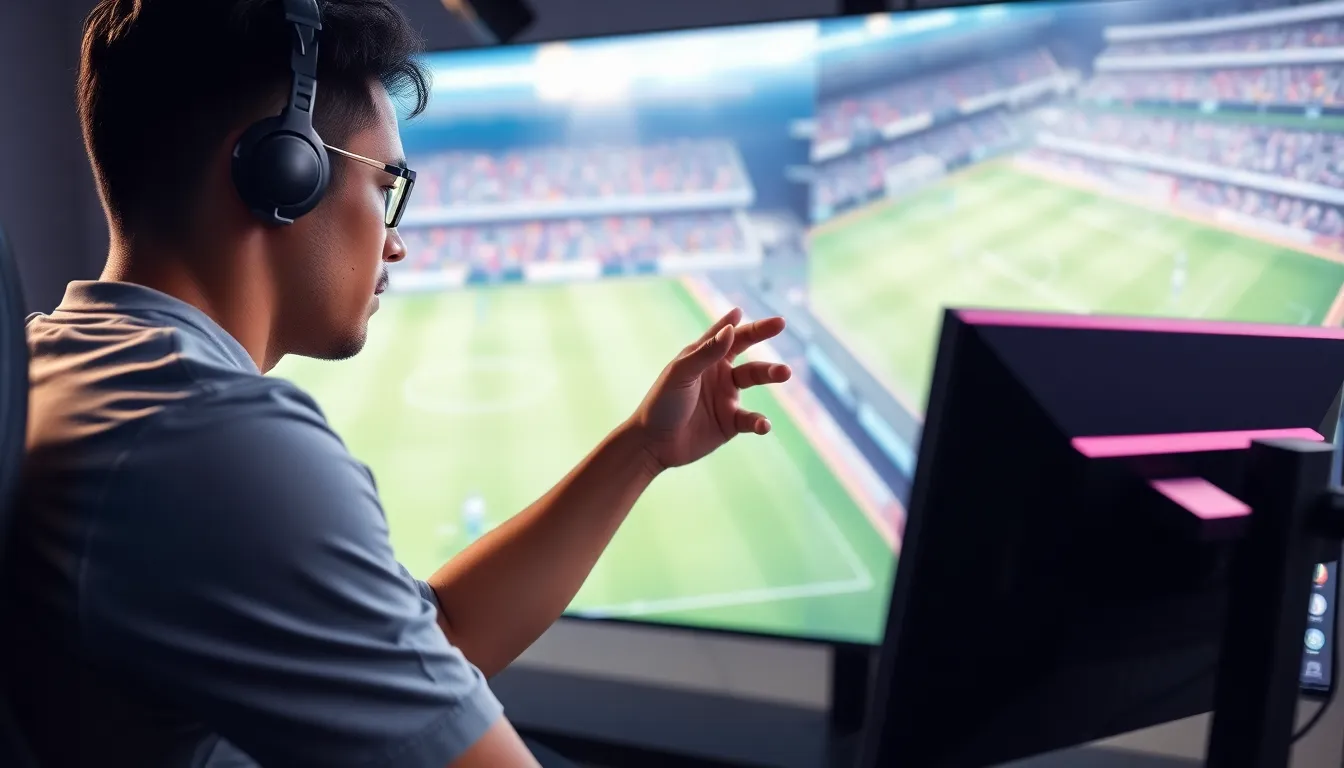In the world of FIFA, where every pixel counts and every virtual kick could lead to glory, pass accuracy isn’t just a stat—it’s the lifeblood of gameplay. Imagine your player, with the finesse of a ballet dancer, effortlessly threading the needle to a teammate while avoiding defenders like they’re mere traffic cones. The difference between a glorious goal and a facepalm moment often boils down to this one crucial metric.
Table of Contents
ToggleOverview of FIFA Pass Accuracy
Pass accuracy serves as a fundamental statistic in FIFA gameplay, influencing overall performance. Achieving high accuracy leads to more successful plays and greater chances to score. This metric reflects a player’s ability to accurately deliver the ball to teammates, minimizing the risk of interceptions.
Factors such as player attributes, distance of the pass, and pressure from opponents all affect pass accuracy. Players with higher ratings in passing skills tend to have more precise deliveries. For instance, midfielders generally excel in passing accuracy due to their central positioning and playmaking roles.
Analyzing pass accuracy can unveil significant insights into team dynamics. Teams that maintain high pass accuracy percentages often control the game better, creating multiple scoring opportunities while restricting opponent chances to counter.
Statistical data illustrate the impact of pass accuracy on a player’s effectiveness. A player with an accuracy rate of 85% or higher typically contributes more significantly to a team’s performance. In competitive scenarios, maintaining pass accuracy above 80% can greatly enhance the likelihood of winning matches.
Improving pass accuracy involves practicing various types of passes, including ground and aerial deliveries. Training drills that focus on quick decision-making and situational awareness also contribute to refining this skill. Ultimately, mastering pass accuracy provides players with a crucial advantage on the pitch, leading to greater success and enhanced gameplay experience.
Importance of Pass Accuracy in FIFA

Pass accuracy plays a vital role in FIFA gameplay, significantly affecting a player’s ability to succeed on the virtual pitch.
Impact on Gameplay
Gameplay is heavily influenced by pass accuracy. Players with high accuracy create more scoring opportunities and evade defenders effectively. Precise passing allows teams to maintain possession and dictate the game’s tempo. According to statistics, teams achieving a pass accuracy above 80% tend to control the match while limiting their opponents’ chances. Higher passing percentages correlate with increased successful plays, leading to a better overall performance. Engaging in specialized training drills enhances passing skills, encouraging quick decision-making and situational awareness. Effective passing ultimately translates to a more enjoyable gameplay experience.
Influence on Player Ratings
Player ratings are directly affected by pass accuracy. A player demonstrating an accuracy of 85% or higher can significantly boost their overall rating. Higher ratings reflect better performance in matches, attracting attention from players and teams alike. Pass accuracy determines not only a player’s skill level but also their contribution to the team’s success. As ratings fluctuate based on performance, maintaining high accuracy becomes essential for recognition and advancement in the game. Consequently, players focused on improving their passing techniques often see positive changes in their ratings, enhancing their virtual careers.
Factors Affecting Pass Accuracy
Pass accuracy in FIFA gameplay hinges on several vital factors. Understanding these can enhance performance on the field.
Player Attributes
Player attributes play a significant role in determining pass accuracy. Players with higher passing ratings consistently deliver more precise passes. Key attributes include vision, passing skill, and agility. Vision influences a player’s ability to assess the field and identify passing opportunities. Passing skill directly correlates with the accuracy of each attempt. Agility enables players to maneuver quickly and make smarter passing decisions under pressure. Players demonstrating accuracy rates of 85% or higher not only uplift their teams but also improve individual performance ratings. Thus, well-rounded player attributes contribute to overall gameplay quality.
Game Settings and Controls
Game settings and controls heavily impact pass accuracy during matches. Settings such as difficulty levels can alter the game’s pace, which affects decision-making. Adjusting camera angles allows players to see the field more clearly, promoting better passing choices. Familiarity with control schemes enhances precision, as players execute passes more effectively with practiced movements. Varying control sensitivities can also alter how passes respond during fast-paced situations. Configuring these settings according to personal preferences maximizes gameplay and boosts pass accuracy, enabling players to create opportunities and maintain possession.
Analyzing Pass Accuracy Statistics
Pass accuracy plays a significant role in evaluating player performance across different FIFA game versions. Comparing pass accuracy statistics reveals trends that demonstrate improvements in gameplay mechanics over time.
Comparative Analysis Across Versions
Pass accuracy has evolved through multiple FIFA versions, showcasing changes in gameplay dynamics. In FIFA 20, the average pass accuracy for top players hovered around 83%, while FIFA 21 saw a slight increase to 85%. Players in FIFA 22 benefited from refined mechanics, achieving an average accuracy rate of 86%. Differences stem from enhancements in player attributes and the introduction of new features that improve passing precision. Players with higher ratings excel in these versions, displaying their skills more effectively. Competitive players often analyze these metrics to adapt their strategies and optimize their gameplay experience.
Trends Over Time
Tracking pass accuracy trends reveals patterns that significantly impact overall gameplay. Year after year, statistics demonstrate an upward trend in accuracy, with top teams maintaining rates above 85%. For instance, in recent FIFA editions, teams consistently achieving over 80% accuracy outperform rivals, reinforcing the importance of precise passing. Statistical data shows players’ focus on training and skill improvement leads to better accuracy. Additionally, changes in game mechanics contribute to these trends, as developers continually refine passing systems. Adapting to these developments enhances player performance, ultimately improving match outcomes and advancing their virtual careers.
Tips to Improve Pass Accuracy
Improving pass accuracy significantly impacts gameplay quality. Players can employ various techniques and strategies to enhance their skills.
Training Techniques
Utilizing targeted drills sharpens passing skills. Players should practice short, quick passes to develop muscle memory. Drills that simulate game scenarios foster better decision-making under pressure. Incorporating exercises focused on vision and awareness enhances overall performance. Consistent practice sessions lead to notable improvements, with many players achieving accuracy rates above 80%. Incorporating feedback from training sessions also helps identify areas for improvement.
In-Game Strategies
Implementing specific tactics during matches enhances pass accuracy. Players can focus on positioning to create clear lanes for passes. Keeping an eye on the surrounding opponents reduces the chances of intercepted passes. It’s beneficial to utilize the right passing techniques based on distance and player movement. Adjusting the tempo of passing maintains opponent confusion and increases scoring opportunities. Effective communication among teammates further improves coordination and execution, leading to higher accuracy in passing success rates.
Mastering pass accuracy is vital for any FIFA player aiming for success. It not only enhances individual performance but also elevates the entire team’s gameplay. By focusing on improving this skill through targeted training and strategic gameplay, players can unlock new levels of effectiveness on the pitch.
With the right approach to practice and an understanding of the factors influencing pass accuracy, players can consistently achieve higher accuracy rates. This commitment to improvement can lead to more scoring opportunities and a greater chance of victory in matches. As FIFA continues to evolve, staying updated with passing mechanics and refining techniques will ensure players remain competitive and enjoy a more rewarding gaming experience.



